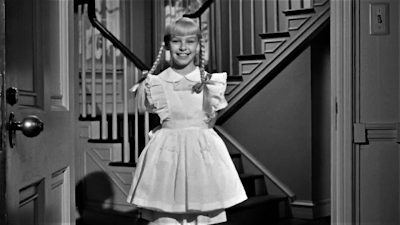“When she was good
she was very very good, but when she was bad she was better.”
In all matters practical, Harriet Craig is the perfect wife.
Beautiful and poised as a hostess, attentive and spuriously deferential to her adoring
husband Walter; Harriet runs their tastefully elegant upper middle-class home with
the efficiency and warmth of a science lab. In that curious definition of “housewife”
indigenous to the moneyed set, Harriet neither cooks nor cleans, raises no
children, and has no job. She merely spends every waking hour running roughshod
over the harried staff of housekeepers (servants, as she likes to call them),
even going so far as to engage Clare, her grateful, poor-relation cousin, as free
labor. All in the service of creating the perfectly clean, perfectly orderly,
perfectly loveless home. Trouble arises when Harriet, fearful that a job promotion for her
husband might loosen the short tether she has kept him on for the entirety of
their marriage, attempts to broaden the scope of her manipulation.
The possessive title of Craig’s Wife, which both the 1928 silent (now considered lost) and the 1936 Rosalind Russell film adaptations retained, hints not only at the original play’s dated mindset, but subtly of its narrative thrust. In both versions Harriet is obsessed with her image and social position and goes to extreme lengths to prevent her name (that of being Craig’s wife) from being involved in any scandal.
Updated for the '50s, Harriet Craig wisely jettisons a distracting murder/suicide subplot that figured significantly in Craig’s Wife and instead settles itself firmly in traditional Crawford territory: a domineering woman attempting to manipulate the lives of those around her. Though melodramatic in structure, this suburban domestic cautionary tale is directed with an appealingly light touch by Vincent Sherman (who also directed Crawford in The Damned Don’t Cry and Goodbye My Fancy), getting overall relaxed performances from the cast that contrast to good effect with Crawford’s appropriately starchy overemphasis.
And therein lies one of the essential guilty pleasures of Harriet Craig (and to the same degree, Crawford’s Queen Bee): it’s like watching Mommie Dearest with the genuine article. I like Crawford very much when she’s good, but she is untouchable playing bad. She is such a raving monster in Harriet Craig that the DVD would not be out of place in a store's horror movie section.
Copyright © Ken Anderson
If ever there was an actress about whom the above quote applies
(wholeheartedly and in all its transmutations) — it’s Joan Crawford: one of the
few actresses I find equally fascinating whether she’s delivering a good
performance or gnawing at the scenery. An actress capable of sometimes
astonishing emotional subtlety, what with the quicksilver flashes of tenderness or
wounded vulnerability those fabulously expressive eyes of hers could convey; she was equally enjoyable as an over-the-top, tough-as-nails,
slightly mannish, bitch-goddesses.
Harriet Craig, the
story of a woman who takes the role of housewife to its literal and tragic
extreme, is a film that had been on my “must see” list since the early '80s when
someone informed me that Crawford’s daughter Christina (she of the incendiary Mommie Dearest) recommended it along
with Queen Bee as the two films to see if you wanted to get a glimpse of what the real Joan Crawford was actually like. Already
acquainted with the extravagant camp of Queen Bee, I finally got to see Harriet
Craig back in 2007 when TCM hosted a Joan Crawford marathon.
The verdict? Well, as a representative page carved out of the
post-Mommie Dearest Joan Crawford
mythos, Harriet Craig doesn't disappoint. On the contrary. The film is full of so much melodrama and
overheated emotion that for long stretches of time it feels as if you’re
watching Joan Crawford as Faye Dunaway portraying Joan Crawford. Harriet
Craig (the third screen incarnation of George Kelly’s 1925 Pulitzer
Prize-winning play Craig’s Wife) is in
many ways the quintessential Joan Crawford vehicle. Drawing upon little more
than the same standard-issue icy imperiousness she brought to almost all of her
post-MGM roles (regrettably, she doesn't slap anyone here, but that’s about the
only thing missing from her usual arsenal), Joan Crawford and her grande dame of the screen image are so
perfectly suited to Harriet Craig, it feels as though the role had been written expressly for her.
 |
| Joan Crawford as Harriet Craig |
 |
| Wendell Corey as Walter Craig |
 |
| K.T. Stevens as Clare Raymond |
 |
| Harriet Craig's cousin Clare, pretty much where Harriet likes to keep her at all times |
The possessive title of Craig’s Wife, which both the 1928 silent (now considered lost) and the 1936 Rosalind Russell film adaptations retained, hints not only at the original play’s dated mindset, but subtly of its narrative thrust. In both versions Harriet is obsessed with her image and social position and goes to extreme lengths to prevent her name (that of being Craig’s wife) from being involved in any scandal.
Much in the manner that the title of Ibsen’s Hedda Gabler suggests the emotional
remove of its protagonist from her married identity of Hedda Tesman, the revamped
Harriet Craig is less about a woman’s
fear of losing her social status as it is about her full and complete fixation
on the marriage state as a means of obtaining emotional and financial security for herself. The husband is merely a means to an end.
 |
| Craig's Law "Marriage is a practical matter. A man wants a wife and a home, a woman wants security." |
Updated for the '50s, Harriet Craig wisely jettisons a distracting murder/suicide subplot that figured significantly in Craig’s Wife and instead settles itself firmly in traditional Crawford territory: a domineering woman attempting to manipulate the lives of those around her. Though melodramatic in structure, this suburban domestic cautionary tale is directed with an appealingly light touch by Vincent Sherman (who also directed Crawford in The Damned Don’t Cry and Goodbye My Fancy), getting overall relaxed performances from the cast that contrast to good effect with Crawford’s appropriately starchy overemphasis.
 |
| Mr. Craig, feeling amorous; Mrs.Craig, sizing up the matrimonial checks and balances |
WHAT I LOVE ABOUT
THIS FILM
A common criticism leveled at the film adaptation of Mommie Dearest was that its screenplay
appeared to have been cobbled together from old Joan Crawford movies. Looking
at Harriet Craig it’s hard to argue
that point. The fictional Harriet Craig is every bit the neat-freak obsessive
that Crawford was made out to be in real life, complete with a poverty-motivated
backstory not dissimilar to Crawford’s own. So closely does Harriet Craig hew to our common perception
of Joan Crawford as an anal-compulsive nightmare, entire scenes of Harriet
going ballistic over some housekeeping transgression could be excised,
colorized, and inserted into Mommie Dearest with disconcerting ease.
And therein lies one of the essential guilty pleasures of Harriet Craig (and to the same degree, Crawford’s Queen Bee): it’s like watching Mommie Dearest with the genuine article. I like Crawford very much when she’s good, but she is untouchable playing bad. She is such a raving monster in Harriet Craig that the DVD would not be out of place in a store's horror movie section.
PERFORMANCES
The much-maligned Joan Crawford is one of my favorite
actresses. Even taking into account her mannered acting style and the severe,
exaggerated appearance she adopted as she matured, to me she remains the most
consistently interesting of the classic leading ladies of the silver screen.
Truth in fact, I think I like her to a great extent because of her stylistic excesses. It’s often said of Crawford that
she was more a movie star than an actress, but I’ve never found her to be any
more one-note than respected studio-system stars like Cary Grant, Katherine Hepburn
or Humphrey Bogart. I just think it’s a matter of taste. Personally, I never
had much of a stomach for
Cary Grant and find him to be one of the more arch and artificial stars (to
borrow a line from Singin’ in the Rain)
in the Hollywood firmament. Crawford, for all her studied emoting is a fascinating screen presence, and while only occasionally genuine, is always interesting.
Like most that have achieved and sustained movie star status,
Crawford’s screen persona and perceived private personality were so
intrinsically intertwined that, intentionally or not, her roles came to be imbued with a voyeuristically autobiographical essence. A phenomenon with Crawford’s
work that has oddly increased, not lessened, over the years. There’s no way to watch Harriet
Craig today without being continually hit in the face with the Crawford mystique.
When scenes are not suggesting some passage from the Mommie Dearest canon of obsessive perfectionist, they’re recalling the
haughty shrew characterization she fairly patented in the look-alike films that come under the heading “Joan Crawford vehicles.”
THE STUFF OF FANTASY
Were I writing about Harriet
Craig back in the '60s or '70s, I would be declaring the film outdated and its
heroine hopelessly out of touch with the ways men and women interact. But here we
are in 2012 and Harriet Craig’s rather cold-blooded philosophies seem to be depressingly right in step with the times. In a comment to my previous post on The Bad Seed, a reader observed how the
confidence and sense of entitlement displayed by Patty McCormack’s Rhoda would likely make her a CEO in today’s world. Similarly, I think Harriet Craig’s
calculating pragmatism when it comes to love and marriage would today land her
a bestselling book deal and make her the darling of the misguided, post-feminist set drawn to reality-TV contests in which women strike bargains to be snapped up by so-called eligible bachelors, or read books that provide "rules" for getting a husband. Making the talk-show circuit, Harriet's 1920s philosophy would no-doubt be seen as "empowering."
THE STUFF OF DREAMS
In appraising Joan Crawford’s Harriet Craig side by side with Rosalind Russell’s Craig’s Wife, I’d say that Russell’s is unquestionably
the better performance (Russell’s performance actually gave me waterworks at
the end), but Harriet Craig is the
better film. The changes made to the original plot result in a tighter
narrative and clearer central focus: Harriet’s pledge to herself never to wind
up like her mother. What it loses is largely due to the lack of depth in either Crawford's performance or the screenplay. Crawford's Harriet is perhaps too steely to inspire much in the way of empathy.
Still in all, the film is a fascinating look at the somewhat superhuman
expectations placed upon women in the achievement of the suburban ideal (add a
couple of kids, a nicer disposition, and some genuine feeling for her husband,
and she’s basically the perfect wife), and in a way, shows what happened to the
role of the film noir femme fatale after the war—she became queen of the house.
 |
| A House is Not a Home |















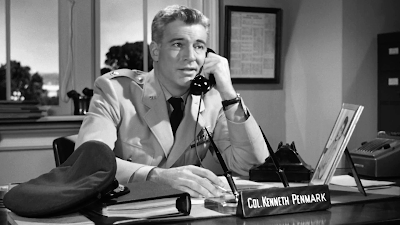





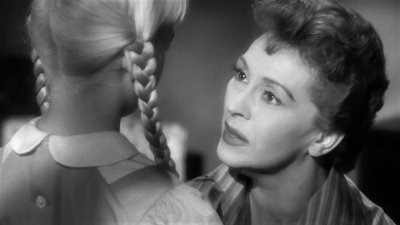







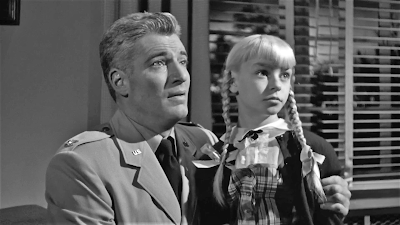


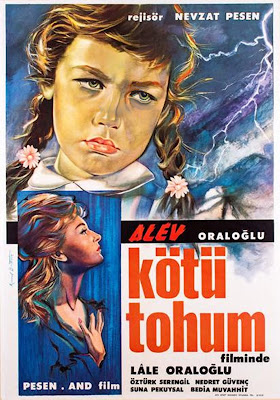
.jpg)

